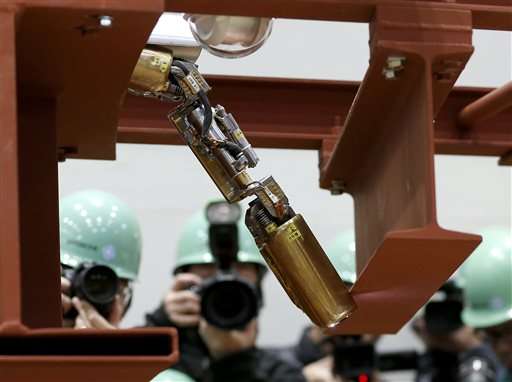First robot into Fukushima reactor stalls, but gets some data

The operator of the wrecked Fukushima nuclear plant said Monday that the first robot sent inside one of the melted reactors stalled before finishing its work but collected data that indicates a path exists to send robots deeper into the reactor.
That's good news for experts designing a robot for a future mission aimed at locating and investigating the residue of the nuclear fuel that melted in the 2011 disaster.
Tokyo Electric Power Co. said the robot stalled after completing about two-thirds of its planned mission Friday inside the Unit 1 containment vessel.
TEPCO spokesman Teruaki Kobayashi said the robot collected temperature and radiation data and images from parts of the platform around the area known as the pedestal below the bottom of the reactor core before it became stuck and unrecoverable. The robot had been intended for only one use because of the high radiation levels.
A second robot mission scheduled for Monday was postponed while engineers investigate the cause of the stalling. Kobayashi said the robot's treads may have become stuck on a grating or in a gap as it moved.
The 60-centimeter (2-foot) -long, snake-shaped robot entered the containment chamber through a pipe and transformed into a U-shape crawler after it landed on the platform.
A 2 ½ minute edited compilation of images transmitted by the robot, released Monday by TEPCO, showed steam wafting from inside the dark container, lit by a lamp mounted on the robot, as it slowly maneuvered around debris that looked like small rocks and metal parts. The images contained numerous white dots believed to be caused by gamma rays.
Kobayashi said the test also showed the robot tolerated radiation and that the levels were significantly lower than anticipated. That means robots can last longer and some wireless devices may even be usable, although the radiation levels were way too high for humans to enter the area, even wearing protective gear.
Without more data, it will be difficult to figure out exactly how to safely locate and remove the radioactive debris. Nuclear officials are expected to revise the plant's decades-long decommissioning roadmap in the coming weeks, with more leeway and options in case earlier plans prove unfeasible.
TEPCO plans to send in a different, amphibious robot next year for a further investigation of the three reactors that suffered meltdowns after the 2011 earthquake and tsunami.
Computer simulations and cosmic ray examinations have shown that almost all fuel rods in the Unit 1 reactor melted, breached the core and fell to the bottom of the containment chamber.
Because of the damage to the reactors, large volumes of cooling water continue to leak from them, causing contamination and hampering the plant's cleanup process.
© 2015 The Associated Press. All rights reserved.





















